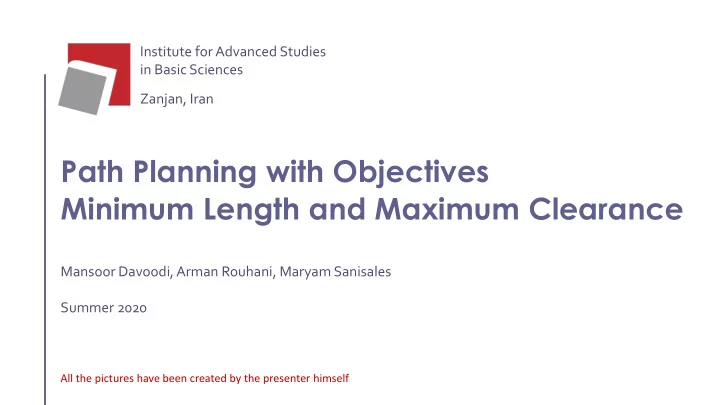

Institute for Advanced Studies in Basic Sciences Zanjan, Iran Path Planning with Objectives Minimum Length and Maximum Clearance Mansoor Davoodi, Arman Rouhani, Maryam Sanisales Summer 2020 All the pictures have been created by the presenter himself
Outline - Introduction - Literature review - Problem definition • Inputs and outputs • Optimal paths - Contribution - Conclusion 1/19
If you optimize everything, you will always be unhappy. - Donald Knuth Donald Knuth 2/19
Path Planning Problem (PP) - A challenging problem in computer science and robotics - A practical problem in industries, game design and daily routine work - The classic PP problem (single objective) • Workspace containing: obstacles, start point s and destination point t • Obstacle-free path for a robot starting from s and ending at t : s-t- path - Multiobjective PP problem 3/19
Path Planning Problem Variations - Single-Objective - Bi-Objective O2 O2 O3 O3 O1 O1 4/19
Literature Review 2020 Ahmed and Deb Davoodi Geraerts Bi-Objective Castillo Elshamli Clarkson Welzl Hershberger . . . Mitchell Gosh 5/19
Clearance as the Second Objective 𝑄 ′ s s 𝑄 6/19
Problem Definition - Bi-objective PP problem - Minimizing Length as the first objective - Maximizing Clearance as the second objective - Input : Simple non-intersecting polygons with total n vertices - Output : Set of Pareto optimal solutions - Length : Manhattan , Clearance : Euclidean 7/19
Pareto Optimal Solutions Extreme Pareto Optimal Paths 𝑄 𝑄 𝑄 𝑄 1 1 1 1 𝑀(𝜌) 𝜌 4 𝜌 4 𝜌 3 𝜌 3 𝑄 𝑄 𝑄 𝑄 𝑡 𝑡 𝑡 𝑢 2 2 𝑡 𝑢 2 2 𝑢 𝑢 𝜌 2 𝜌 1 𝜌 2 𝜌 1 C (𝜌) 𝑄 3 𝑄 𝑄 𝑄 3 3 3 (𝑐) (𝑏) (𝑑) (𝑒) (𝑓) 8/19
Literature Review Cont. 2020 Ahmed and Deb Davoodi Geraerts Wein Castillo Elshamli Davoodi Clarkson Welzl • Deterministic algorithm in grid workspace Hershberger . . . • O ( n 3 ) time algorithm in continuous workspace Mitchell Gosh 9/19
Contribution 10/19
Algorithm Tangent points - SP algorithm - Rectilinear path - Computing tangent points - Performing Dijkstra - Constructing tree T 11/19
Algorithm Cont. - Tree T - Segment dragging 12/19
Algorithm Cont. Type 3 event: Two obstacles intersect at some clearance λ - 13/19
Algorithm Cont. SP Tree MWVD DS Type1 & Type2 - Intervals Tree SP MWVD DS Type1 & Type2 O(n) intervals Intersection Event Tree SP MWVD DS Type1 & Type2 14/19
Algorithm Cont. - Type 1 event : A tangent point reaches an MWVD edge Type1 critical clearances in each interval are stored in a HEAP structure 15/19
Algorithm Cont. - Type 2 event : Two tangent points reach the same x or y coordinate. Type2 critical clearances in total are stored in a SORTEDLIST 16/19
Complexity SP Tree MWVD DS Type1 & Type2 O(n log n) O(n) O(n log n) O(1) Heap: O(log n) List: O(1) In total O(n) Intersection Event Type2 : O( n 2 * n log n) = O( n 3 log n) O( n 3 log n) Type1 : O(n * n log n) = O( n 3 log n) x O(n) 17/19
Conclusion - Bi-objective PP problem - Minimizing Length and Maximizing Clearance O( n 3 log n) time algorithm - - Extreme Pareto optimal solutions - Length : Manhattan , Clearance : Euclidean ( 𝟑 ,1)-approximation - 18/19
References 1. Clarkson, K., Kapoor, S., Vaidya, P.: Rectilinear shortest paths through polygonal obstacles in o (n (log n) 2) time. In: Proceedings of the third annual symposium on Computational geometry. pp. 251{257 (1987) 2. Davoodi, M.: Bi-objective path planning using deterministic algorithms. Robotics and Autonomous Systems 93 , 105- 115 (2017) 3. De Berg, M., Van Kreveld, M., Overmars, M., Schwarzkopf, O.: Computational geometry. In: Computational geometry, pp. 1-17. Springer (1997) 4. Geraerts, R.: Planning short paths with clearance using explicit corridors. In: 2010 IEEE International Conference on Robotics and Automation. pp. 1997-2004. IEEE (2010) 5. Ghosh, S.K., Mount, D.M.: An output-sensitive algorithm for computing visibility graphs. SIAM Journal on Computing 20 (5), 888-910 (1991) 6. Hershberger, J., Suri, S.: An optimal algorithm for euclidean shortest paths in the plane. SIAM Journal on Computing 28 (6), 2215{2256 (1999) 7. Hwang, F.K.: An o (n log n) algorithm for rectilinear minimal spanning trees. Journal of the ACM (JACM) 26 (2), 177- 182 (1979) 8. Inkulu, R., Kapoor, S.: Planar rectilinear shortest path computation using corridors. Computational Geometry 42 (9), 873-884 (2009) 9. Mitchell, J.S.: L 1 shortest paths among polygonal obstacles in the plane. Algorithmica 8 (1-6), 55-88 (1992) 10. Wein, R., Van den Berg, J.P., Halperin, D.: The visibility-voronoi complex and its applications. Computational Geometry 36(1), 66-87 (2007) 19/19
Thank You
Recommend
More recommend